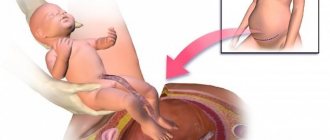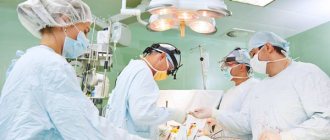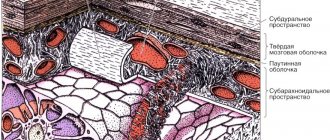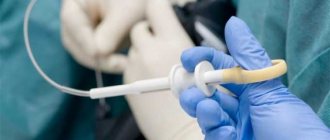Childbirth by caesarean section is one of the oldest surgical operations. There are many indications for its implementation; the main goal of the manipulation is to preserve the health and sometimes the lives of the mother and baby.
In our realities, a cesarean section is performed strictly according to indications, and after the operation is completed, doctors continue to closely monitor the woman’s well-being and the recovery processes in her body. After all, despite the fact that this operation seems quite simple, and medical technologies are constantly improving, it is still a surgical intervention.
Expert opinion
What exactly and how should a woman be monitored if she has had a caesarean section, says Elena Borisovna Machneva
, Candidate of Medical Sciences.
Of course, the recovery processes after a natural birth and after a cesarean section birth are different. During childbirth, many changes occur in a woman’s body, for which nature prepared the expectant mother throughout pregnancy. These are various changes in the cardiovascular, endocrine, respiratory systems, blood coagulation system, etc. Some of these changes are activated during a cesarean section, while others follow a different scenario.
At the same time, during surgical childbirth, the woman’s body is subjected to additional load and stress due to systemic or local anesthesia, as well as the large wound surface that occurs as a result of abdominal surgery. Therefore, in addition to the general recovery processes, in the postpartum period after a cesarean section there are also processes of restoration of the nervous system after anesthesia, as well as healing processes of postoperative sutures.
Since both normal and cesarean births always go differently for everyone, the recovery period for each individual woman also has individual characteristics. A woman should definitely consult with the obstetrician-gynecologist who delivered or operated on her about these features and about the protective regime after childbirth.
How is a caesarean section different from a normal birth?
Caesarean section is considered less traumatic and has a higher percentage of positive outcomes than natural childbirth, when, for example, a woman may die due to blood loss.
Caesarean also eliminates perineal ruptures and lasts about 45 minutes, while natural childbirth can last 12 hours or more. Due to the fact that during a caesarean section the woman does not have to push too hard, the risk of birth injuries to the baby is reduced.
The negative aspects include:
- risk of complications;
- long recovery period;
- the negative impact of anesthesia on both the woman and the baby.
If a woman does not have specific indications for surgical intervention, then, of course, the best option for her would be to go through a natural birth.
When passing through the birth canal, the child passes his first obstacle, which will benefit him, and for the development of the reproductive system, it is important for girls to receive a portion of the mother’s microflora, which can only happen during normal childbirth.
There is a recovery period for both cesarean and natural childbirth, the only difference is the time it takes for the woman to recover. With caesarean, the rehabilitation process still lasts longer and there are reasons for this: blood loss, surgical intervention.
Consequences of caesarean section for a child
The consequences will be not only for the mother, but also for her baby. Often those who are brought into the world through surgery have problems with the respiratory system. It is worth remembering that general anesthesia is used to perform a caesarean section. And the drug in a certain amount passes through the placenta into the baby’s blood. Therefore, the respiratory center is somewhat depressed at birth. Possible asphyxia.
In the first days and even in the first few weeks after a cesarean section, the baby may be lethargic and reluctant to eat. Also, fluid and mucus remain in the lungs of babies who are removed through the mother's abdomen. If the baby passed through the mother's birth canal naturally, the excess contents would come out on its own. The liquid that remains there is absorbed into the lung tissue. Therefore, after a cesarean section, the child may have hyaline membrane disease.
Pathogenic bacteria multiply in the mucus that remains in the Caesar baby's lungs. Therefore, the risk of respiratory disorders is high. First of all, it is pneumonia. When a baby is born without surgery, he sleeps, which is medically called hypernation. Physiological processes in his body slow down, and this protects the child from a sharp increase in pressure on his body.
When a cesarean section is performed, the baby is delivered quickly, and the baby’s body is not prepared for the change in pressure. Therefore, microhemorrhages can form in the brain. Children who are removed through abdominal surgery adapt less well to the world because they did not have the stress of birth. That is, there was no production of hormones responsible for adaptation processes (catecholamines).
Long-term consequences of cesarean delivery for the child:
- problems with breastfeeding
- food allergies in many cases
- increased level of excitability, hyperactivity
- poor weight gain
While the woman is recovering from general anesthesia (as noted above), she cannot feed the child. Then she is given antibiotics, which also stops breastfeeding. That’s why the baby is fed artificial formula. As a result, he does not latch onto the breast well and does not want to suck (after all, sucking from a nipple is easier than from the mother’s nipples). It is worth noting that after a caesarean section, the mother does not immediately take the baby. Therefore, no special early psychological connection is formed. It is difficult to predict what consequences this will have physiologically and psychologically.
Recovery after anesthesia
Nowadays, a woman can choose the type of anesthesia that will be used to numb her. However, doctors also pay attention to the following factors when choosing an anesthesia method:
- condition of a pregnant woman;
- fetal condition;
- planning of the operation;
- safety of drugs for mother and child;
- availability of a qualified specialist.
General
This method is most often used in emergency situations as it requires less time to administer. First, the woman is given a “preliminary anesthesia” intravenously. A tube is inserted into the trachea through which a mixture of oxygen and anesthetic gas is supplied, a drug is injected that relaxes the muscles and the uterus, after which the operation itself begins.
Indications for the use of general anesthesia:
- emergency section;
- with a transverse, oblique position of the fetus;
- refusal of regional anesthesia;
- with prolapse of the umbilical cord;
- if there are contraindications for epidural anesthesia.
There are practically no contraindications to general anesthesia, however, there are a number of complications or side effects:
- headache, dizziness;
- cough and sore throat from the tube;
- nausea, muscle pain;
- allergic reactions, respiratory tract infections.
General anesthesia has a greater effect on a child than epidural anesthesia:
- possible toxic effects on the brain, development of perinatal encephalopathy;
- lethargy, drowsiness.
Spinal
This method of anesthesia is used for planned surgery, but sometimes also for emergency surgery, if there are 10-15 minutes of time left. Spinal anesthesia has a number of advantages:
- the drugs used for this anesthesia do not affect the child;
- a small dose of anesthetic is administered, thereby reducing the risk of toxic poisoning if it accidentally enters the blood;
- the anesthetic acts very quickly, which is important, since when the medicine acts, the pressure in the woman’s lower body drops, which leads to oxygen starvation, which means the child needs to be delivered as quickly as possible;
- the muscles of the body completely relax;
- the risk of breathing problems decreases, since the woman is conscious;
- a woman immediately hears the first cry of her child and can put him to her breast.
But there are also disadvantages:
- there is a sharp drop in pressure due to which it is raised artificially before the operation, and since the pressure rises in the mother, it also increases in the child, which can subsequently negatively affect his nervous system;
- the dose of the medicine is one-time and cannot be changed, which indicates that if there are any complications that will increase the duration of the operation, the patient will also have to endure general anesthesia;
- possible manifestations of headaches.
For a child, the most important complication is oxygen starvation, which occurs as a result of a drop in pressure.
Epidural
An anesthetic substance is injected into the spinal canal, as a result of which the woman loses sensitivity in the lower part of the body, but her consciousness remains clear. This method is most often used during planned operations, when there is time for its preparation. In emergency situations, it is problematic to carry out such a procedure quickly.
Epidural anesthesia has contraindications:
- inflammation of the skin at the puncture sites;
- diseases of the spine;
- acute infectious diseases;
- bleeding disorders;
- allergies due to intolerance to anesthesia drugs;
- narrow pelvis and heavy weight in the child;
- in some cases, a scar on the uterus;
- oblique or transverse placement of the fetus.
It is also possible to develop side effects and complications, which are much more common due to the large dose of the drug. Their presence may depend on the skills of the anesthesiologist, but most often the following side effects occur:
- headache;
- trembling in the legs;
- backache.
The child may experience a decrease in heart rate, hypoxia and respiratory failure. But a competent pediatrician can very quickly cope with all these complications.
Observation by a gynecologist
Women in labor who have undergone abdominal extraction of the baby are registered with the antenatal clinic. The observation period is 2 years. You should visit your doctor for the first time after giving birth no later than 10 days later. During this visit, all mothers undergo an ultrasound examination of the uterus.
6-8 weeks after birth the discharge (lochia) ends, then another visit should take place. The next scheduled visit to the gynecologist should be 6 months after the operation. During this visit, the doctor assesses the condition of the uterine scar. Then they want to see a doctor once every 6 months, sometimes more often.
Rehabilitation of the body after cesarean section
After childbirth, very big changes occur in the woman’s reproductive system, and for a long time the body comes to its senses and recovers. However, it should be understood. That such a process can drag on for months, and sometimes even a year or two.
Uterus
Immediately after the procedure, the uterus resembles a continuous bleeding wound - its bottom drops 4-5 cm below the navel, the diameter is 10-12 cm. Contractions of the cervix are very weak and gradually intensify.
The postpartum period lasts about two months. But the uterus is in no hurry to contract so quickly, since the operation disrupts the integrity of the muscle fibers of the uterus, blood vessels and nerve endings.
If necessary, a woman may be prescribed additional drug therapy, which will stimulate the contractile activity of the uterine muscles and reduce bleeding.
After the operation, the woman remains in a special ward for the first 24 hours and is under the constant supervision of doctors. The nurse should clean the suture every day with an antiseptic solution and change the dressings.
An ice pack is placed on the woman's stomach as this helps the uterus contract and stop bleeding. Painkillers are also prescribed to stimulate contractions and drugs to restore the gastrointestinal tract.
It is important for a woman to fully recover, so some restrictions will appear in her life that will not prevent the uterus from healing. The scar is completely formed by the end of the first year after cesarean.
Visit your doctor and get an ultrasound to stay informed about how the recovery process is going. If you are planning another pregnancy, take x-rays in frontal and lateral projections, and also undergo hysteroscopy - a visual examination and examination of the scar by inserting an endoscope into the uterine cavity 8-12 months after surgery.
The rate of healing of the uterus also depends on how the pregnancy proceeded, at what age the woman gave birth, and on the conditions of the operation.
The seam
The incision on the uterus is usually sutured with a single or double-row suture without interruption - for this, special materials are used (Dexon, monocryl, caproag, etc.), which can resolve on their own from several weeks to 3-4 months.
After suturing, doctors will monitor their condition so that inflammation does not start. A postoperative scar takes the longest to heal – from 6 months to a year. This is due to the fact that when making an incision, the integrity of the nerve endings is disrupted.
The woman needs to take painkillers for several days after the operation, as the stitch will be very painful. The skin scar forms after about a week. To relieve discomfort, it is recommended to wear a postpartum bandage or bandage the abdomen with an elastic bandage.
To prevent the seam from becoming inflamed, you can lubricate it 1-2 times a day with lavender or tea tree oil, having previously dissolved it in vegetable oil in a ratio of 1:10. Pharmacy calendula ointment is also suitable.
Menstruation
The return of the cycle after surgery is influenced by many different factors:
- age;
- combination of load and rest;
- nutrition;
- complications during pregnancy;
- lifestyle before and after childbirth.
However, the main factor that can affect the return of menstruation is lactation. This is due to the fact that during breastfeeding, the hormone prolactin is actively produced, which does not have the best effect on the ovaries, and the more the body produces this hormone, the more sluggish the ovaries become.
Therefore, while a woman puts the baby to her breast, the appearance of menstruation is unlikely, but if initially there was no milk, then already 2-3 months after the operation, menstruation can begin again, a couple of weeks after lochia.
The first critical days after a cesarean section will be characterized by severe bleeding - this situation should last no more than 2 months. However, if this situation continues to bother you for a long time, you will need to consult a doctor, since strong discharge may indicate the presence of hyperplasia or other diseases.
For the first 3-4 months, the cycle will be inconsistent, which is not something to worry about, as well as the absence of ovulation in the first month - this is a completely normal phenomenon, given all the characteristics of the body. After this period, the cycle should normalize - between periods should pass from 21 to 35 days, and the duration may go beyond 3-7 days. If this does not happen, you should consult a doctor.
Scanty, not abundant menstruation is not a good sign; most often it indicates that the uterus is not contracting enough, which means the development of stagnant discharge and inflammation is possible. Spotting blood before or after menstruation indicates endometritis.
If the discharge resembles a curd mass and is accompanied by itching, it means that the drugs taken during the recovery period caused thrush, which is dangerous in the postpartum period.
To quickly restore your menstrual cycle, you need to:
- observe the regime;
- abstain from vaginal sex for at least 3-4 months;
- limit hygiene procedures - avoid hot showers and the use of tampons;
- protect yourself.
Intimate life
You should not resume sexual activity immediately after a cesarean section, no matter how much you might want to - the wounds are still healing, the stitches may bleed and hurt. The body needs time to recover and recover to avoid suture ruptures.
Despite the fact that it takes about 2 months to restore the body, this is still a fairly arbitrary period, since everything depends on the individual characteristics of the woman.
Doctors say that you can start intimate life when postpartum bleeding has stopped and there are no problems with the stitches. But in order to make sure of this, you should undergo an ultrasound. After the examination, the doctor will tell you whether you should wait longer or not.
In order for intimate life to be enjoyable and not end in complications, several rules should be taken into account:
- all movements of the partner must be careful and smooth - sharpness, roughness and deep penetration are excluded;
- think over the issue of contraception so that another pregnancy does not happen;
- for six months you can use only classic positions that do not involve deep penetration;
- give your body time to regain its tone.
An important nuance is that by the time a woman is physically ready, her partner will also have to undergo an examination and make sure that he is healthy and will not cause any harm to the woman.
Sex life
1.5-2 months after a cesarean section, as after a natural birth, you can make love. This is necessary so that the place where the placenta was previously attached to the uterus is completely healed, and so that a full-fledged suture is formed on the uterus. Before you resume intimate relationships, consider contraception.
Women after cesarean section should know that installation of an intrauterine device is possible six months after the operation, and not earlier! Abortions cannot be done, because they lead to disruption of the uterine suture, and therefore the scar may become insolvent.
Figure restoration
To return your figure to its previous state, it is first of all important to improve your diet. Since physical activity is allowed only after the suture has healed. You should not trust the reviews of other mothers in this matter; you should get permission from your doctor.
Nutrition
On the first day you should avoid solid foods. Most likely, a woman will have to make do with just water, which can be diluted with fruit juice in a ratio of 100 ml to 1 water.
It is better to choose lemon, as it will help restore lost strength, strengthen the immune system, and have an anti-inflammatory and disinfecting effect. The woman receives all other nutrients needed for recovery from IVs.
On the second day, the list of foods that you can eat expands. These include:
- meat broth with chicken or beef;
- skim cheese;
- juice, tea, rosehip decoction, jelly, compote;
- lean meat;
- homemade yogurt without additives.
Adhering to such a diet, a woman helps her body quickly rehabilitate after suffering stress. On the third day, the menu becomes even more varied. In addition to all of the above products:
- steamed cutlets or meatballs;
- cheese;
- meat and vegetable purees;
- porridge with water;
- baked apples;
- kefir if you have problems with stool.
Naturally, all products on the menu must be agreed upon with the attending physician. They should not irritate the intestines or cause gas or constipation. The dishes should be kept warm, and after 3 days the nursing mother should be given a full diet.
Yoga
You can start practicing yoga 42 days after a caesarean section. Throughout this period, physiological recovery occurs:
- tissues become scarred;
- swelling of the external genitalia subsides;
- the uterus contracts and returns to its original size;
- internal organs take their previous position.
These days are the most difficult period after surgery, when exercise should be avoided so as not to overstrain the muscles. Yoga cannot be practiced after cesarean section if you have the following diseases:
- uncompensated heart disease;
- arthritis, arthrosis;
- severe fatigue;
- increased body temperature;
- exacerbation of ulcers;
- spinal injuries;
- blood pathologies, etc.
You should not do yoga immediately after eating. The optimal time between meals and training is 2 hours. Another limitation is visiting the sauna. If the training is carried out correctly, the woman will observe only positive changes:
- muscle elasticity will increase;
- flexibility improves and muscles tighten;
- weight loss;
- the uterus is strengthened;
- breathing is restored;
- depression goes away;
- pain in the lumbar region is eliminated;
- the functioning of the gastrointestinal tract improves.
Exercise overview
A few hours after the operation, you can perform simple gymnastic exercises, as well as chest and abdominal massage:
- Place your hands behind your back and stroke the lumbar region with the back and palmar surfaces of your hands from top to bottom and to the sides.
- Holding the area of the sutures, perform deep breathing with your stomach - inhale for 1-2 steps, inflating your stomach, exhale for 3-4 steps, drawing in your stomach as much as possible.
- Stroking the front and side surfaces of the chest from bottom to top towards the armpit area. The left side is massaged with the right hand, the right side with the left.
- Cough while supporting the suture area with your palms.
There are exercises that can be performed the very next day after surgery. Starting position - sitting with emphasis on your back, perform the exercises slowly up to 10 times:
- pull socks toward and away from you;
- rotate your feet in and out;
- press your knees together and then let go;
- tense and relax the gluteal muscles;
- bend one leg and stretch it forward, lower it and repeat the exercise with the second.
Also useful are Kegel exercises to strengthen the muscles of the perineum and pelvic floor. You need to squeeze the muscles of the perineum in such a way as if you wanted to hold a stream of urine and hold it in tension for a few seconds, then relax. You need to perform 10-20 repetitions at a fast pace 3-4 times a day and gradually increase the tension time by 1 second, reaching 20 seconds or more.
If you perform this exercise regularly, you can avoid problems with urinary incontinence.
After the stitches are removed, you can begin light exercises for the abdominal muscles:
- Take a sitting position and bend your back slightly, inhale and exhale, and as you exhale, draw in your stomach. Stay in this position for 1 second, then relax your stomach and exhale. Perform 10-15 repetitions several times a day.
- Lie with your back on a hard surface and bend your knees. Lift your pelvis up without lifting it and lower it down. Perform 15-20 repetitions several times a day.
Exercise and recovery
After abdominal extraction during childbirth, you can lift heavy objects weighing up to 4 kg for 3 months. You can lift the child. Other family members should take on housework. After cesarean section, it is not recommended to squat or bend over. Therefore, a woman will not be able to do some of the housework. 30 days after a cesarean section, you can do gymnastics, but do not overwork yourself.
6 months after a cesarean section, you can begin pumping up your abs (abdominal muscles). The tummy should return to its previous shape in half a year or a year. To restore the previous proportions of the figure and restore sexuality, you need to engage in the following types of exercise:
- yoga
- bodyflex
- aerobics
- group fitness (or home video classes)
The program should be designed taking into account the fact that you gave birth using abdominal extraction. Also, the gynecologist should approve physical activity, because you may think that you can already be active, but the doctor will have a different opinion.
Answers to popular questions
After such an operation, and in general with the birth of a child, adjustments may be made to a woman’s usual way of life. Therefore, questions may arise regarding some points.
When does breastfeeding start?
After the section, problems with lactation may arise. This is due to a large number of reasons:
- weakness;
- violation of the newborn's adaptation;
- child's drowsiness, etc.
During natural childbirth, milk comes in 3-4 days, and after surgery it occurs with a delay - about 4-5 days. This happens because during natural childbirth, a woman releases hormones into her blood that stimulate milk production. After a cesarean section, this hormone begins to be released with some delay.
This is also related to nutrition - after the operation, the woman eats practically nothing for several days, which is why the quality and quantity of the milk noticeably suffers.
Immediately after the operation, milk production is almost 2 times lower compared to spontaneous birth. And milk has a low content of main ingredients. It is necessary to ensure that the baby is attached to the breast in the first 2 hours after surgery.
When can you get up, walk, sit?
You can get up and walk after surgery in 6-8 hours - some women literally learn to walk again. But the earlier you get up, the better. Walking prevents intestinal motor dysfunction and the formation of adhesions.
You need to get up gradually, without sudden movements - move closer to the edge, turn on your side, lower your feet to the floor. Place one hand on the bed and hold the seam area with the other. Sit down slowly, sit, then stand and stand, leaning on the bed, trying to keep your back straight.
How much weight can you lift?
During the recovery period after a cesarean section, a woman should not lift anything heavier than a baby. She should forget about all sorts of baths, grocery bags, and strollers. After a caesarean section, it is better to use a sling, which will allow you to keep your baby close and close to you, while leaving your hands free. The only caveat is that it is better to wrap the sling higher so as not to accidentally touch the seams.
When can you lie on your stomach and side?
It is possible and necessary to lie down or sleep on your stomach or side after a cesarean section, but this must be done correctly and gradually. You can try to roll over for the first time a few hours after the operation, but only if everything went without complications.
When turning over, pain will appear and at first it will be very strong, so much so that it is unlikely that you will be able to hold out in this position for more than 5-10 minutes. Do not tolerate this pain - turn over every 2-3 hours, but not for long and you will notice that the pain decreases.
You cannot lie on your stomach or sleep in this position with a postpartum bandage, as it will disrupt normal blood circulation and reduce the therapeutic effect.
When can you take a bath and shower?
There are no restrictions on taking a shower, but many still prefer to take a shower at home, having previously sealed the seam with a plaster - for such purposes, you should choose one that is glued to the skin around it, and not to the seam itself. But it won’t be possible to take a bath any time soon – it is contraindicated for at least two months.
When can you get pregnant again?
The scar after a cesarean section remains on the uterus for life, which naturally can have a negative impact on the course of the next pregnancy, therefore, you should be careful about your health when you decide to have a child again.
From the point of view of the condition of the scar, doctors advise planning the next pregnancy no earlier than 2-3 years after the operation. By this time, the body will have already recovered from the previous pregnancy.
It is also not known whether a woman with a scar can give birth to a subsequent child naturally, since the presence of a scar itself is already an indication for a cesarean section, and the restoration of the body may not be as complete as the woman would like. The condition of the scar is assessed using ultrasound, and the birth process itself is strictly controlled by doctors and obstetricians.
When is it allowed to play sports?
You should be very careful in this matter and take your time, since any physical activity after cesarean section is allowed only 60 days after birth. There is no need to worry that you won’t be able to restore your figure within a certain period of time. The most important thing at this moment will be the restoration of the body’s condition. And only then finalization of the external component.
When can you sit down?
After the first day of bed rest, mommy can get up. Turn onto your side and lower your legs out of bed first. Then focus on your hands, raise your torso and sit on the bed. Sit and listen to the sensations of your body. Then you can rise to your feet, holding onto the bed or an assistant is not excluded. Wait, get used to this position. Then take steps at a leisurely pace. A nurse or husband should supervise walking.
Early physical activity of a woman after a cesarean section is important so that the intestines work as they should and so that adhesions do not form. The seams on the skin should be wiped every day with antiseptic solutions:
- potassium permanganate
- brilliant green (“zelenka”)
- alcohol 70%
The bandage on the stitches is also changed every day. Stitches after a caesarean section are removed for a woman on the 7-10th day. Shock inside the skin, if one was done, resolves on its own without removal 2 or 2.5 months after delivery. To prevent a keloid scar, it is recommended to smear the seams with gels such as Contractubex and Curiosin. They are available in almost all pharmacies and are available without a prescription.
Mommy can take a shower after the stitch has been removed. As already noted, this is 7-8 days after birth. It is better not to rub the seam with a washcloth. Baths after cesarean section cannot be taken for 60 days. When your postpartum discharge has stopped and your scar has healed, then you can think about a bath or sauna.
Psychological recovery
It is not uncommon for young mothers to need psychological recovery, especially for those who know about the consequences of this operation. For example, complications in the baby’s health. A woman may feel guilty.
Psychologists say that a woman in such situations has the right to experiences and emotions. And under no circumstances should you keep them to yourself. Share what worries you with your family and friends, consult a specialist. Immerse yourself in caring for the child and think that everything has already happened, it cannot be changed. A caesarean section is a fait accompli that you shouldn’t get stuck in for too long.
What is the postpartum period?
The postpartum period is the period during which the reverse development of those organs and systems that have undergone changes due to pregnancy and childbirth ends. Typically, this period, taking into account the individual characteristics of pregnancy and childbirth, lasts 6-8 weeks. An exception is the mammary glands, the function of which reaches its maximum development during the first days of the postpartum period and continues during lactation.
The main task of the postpartum period is the prevention of infectious complications in the woman and newborn. In this regard, a woman’s compliance with the rules of personal hygiene is especially important. Penetration of infection into the genital tract and mammary glands poses a great danger to the health of mother and baby.
Reviews from women who have had a caesarean section
Natalya, 25 years old, economist, Moscow. I went for a caesarean section on my own, without any indication. The operation went very well, I was given spinal anesthesia, I saw and heard everything. There was no severe pain, there was discomfort and the milk came only on the third day. Now 3 months have passed since the operation, the stitch practically does not bother me, I followed all the instructions. In general, I don’t regret my decision one bit.
Olga, 28 years old, salesman, Voronezh. At the final gynecological examination, it turned out that I had a deformation of the pelvic bones. We decided to go for the operation, it went quickly. The anesthesia went well, I recovered from it for an hour and a half after the operation, and the child was born healthy. They brought me my daughter only on the 4th day, when I already felt almost healthy, could stand, walk, and even began to slowly breastfeed her. I survived all the problems, because the most important thing was that my daughter was completely healthy.
The rehabilitation period after cesarean section requires a lot of attention and effort. Because the woman’s future health and her ability to give birth again depend on how it goes. You should listen to all the doctor’s recommendations, don’t be shy to ask for help, don’t take on the entire burden of responsibility and responsibilities, and then everything will be fine.
Nutrition, intestinal gases
The release of gases is important for the intestines to regain their function after abdominal delivery. A young mother needs a diet without fail. In the first 24 hours after cesarean section the following is allowed:
- mineral still water
- water with lemon juice
On the second day you can have the following products:
- kefir
- meat minced or chopped in a blender
- cottage cheese 0% fat
- chicken or meat broth
The stool returns to normal on the 4-5th day after surgery in most cases. Then you can eat as usual. A woman in labor should not retain gas. To make them easier to pass, stroke your stomach clockwise, then turn on your side, lift your leg and release gas. If you have constipation, doctors prescribe Microlax or glycerin suppositories. They are not transmitted to the baby through milk.
Diet after discharge
If a cesarean section did not produce any complications, and the state of the gastrointestinal tract is satisfactory, then in this case the woman’s diet can be as varied as possible. Of course, there are still exceptions and they must be respected. Some foods are prohibited during lactation. Specialists determine the list of permitted products after discharge:
- milk and dairy products;
- vegetables that do not lead to increased gas formation;
- cottage cheese;
- meat;
- apples, pears, peaches, bananas, plums;
- vegetable oil and butter;
- eggs;
- vitamin complexes;
Important:
Bananas are a rather controversial product because, despite their widespread sale, they are still an exotic fruit for us. If there are any prejudices against them, then it is better to exclude them from the diet.
The products presented above will not harm the woman and her health in any way, nor will they lead to allergic reactions in the baby. However, the diet still has its limitations. The most difficult period is the first week after cesarean. At this time, it is better to remove from the diet:
- honey;
- garlic;
- citruses;
- Exotic fruits;
- strawberries;
- mayonnaise and spices;
- carrot;
- smoked products;
- canned food;
- sausages;
- chocolate.
Proper nutrition at this stage will help improve the quality of lactation and significantly shorten the recovery period for the woman in labor. Thus, she will be able to quickly return to normal life without risking her health and the health of her baby.











